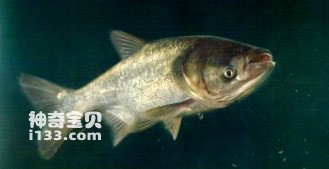Bighead carp (Aristichthys mobilis) belongs to the order Cypriniformes, family Cyprinidae, subfamily Aristichthys, and genus Bighead Carp. Commonly known as: silver carp, fat-headed fish, black silver carp, yellow silver carp, pine carp, catfish, big-headed fish. English name: Bighead, Bighead crap.
Bighead carp has flat sides and an extremely enlarged head. The mouth is large, end-positioned, with the lower jaw slightly tilted upward. Gill rakers fine and leaf-like, but not united. There are spiral-shaped epibranchial organs in the upper part of the oropharyngeal cavity. The eyes are small, low-lying, and without whiskers. The hypopharyngeal teeth are spoon-shaped and have smooth tooth surfaces. The scales are small, and only the pelvic fins and even the anus have cortical ventral ribs on the ventral surface. The pectoral fins are long, with the end extending far beyond the base of the pelvic fins. The upper part of the body is gray-black, the abdomen is gray-white, and there are many light yellow and black irregular small spots on both sides.

Bighead carp like to live in the middle and upper layers of still water. Their movements are slow and they don't like to jump. It mainly feeds on zooplankton and also eats some algae. The age of sexual maturity is 4-5 years old. The broodstock breeds from May to July in river sections with whirlpools in rapids when the water temperature is 20-27°C. Young fish usually go to lakes and affiliated water bodies along the river to be fattened. When mature, they breed in rivers, and later return to lakes where food is abundant for fattening. In winter, they mostly inhabit river beds and deep rock pits to survive the winter.
Distributed in eastern Asia, this fish is found in all major river systems in my country, but the main production areas are in the middle and lower reaches of the Yangtze River Basin.
Bighead carp grows rapidly. The 3-year-old fish can reach 4-5 kilograms, and the largest individual can reach 40 kilograms. The natural yield is very high. It has few diseases and is easy to raise. It is one of the "four major fishes" in my country's freshwater aquaculture industry and is an important economic fish in my country.
The nutritional content of bighead carp muscle is: per 100 grams of edible part, it contains 73.2-83.3 grams of water, 14.8-18.5 grams of protein, 0.9-7.8 grams of fat, 1.0-1.3 grams of ash, 0.1-1.3 grams of nitrogen-free extract, and 69,000 calories. Calcium, calcium 36 mg, phosphorus 187 mg, iron 0.6-1.1 mg, thiamine 0.02 mg, riboflavin 0.15 mg, niacin 2.7 mg. Moreover, as the fish body grows and develops, the water content gradually decreases, while the protein and fat content gradually increase. The fat content of bighead carp and silver carp is different, mainly due to different foods. Silver carp and bighead carp are both filter-feeding plankton, but silver carp mainly feeds on phytoplankton, while bighead carp mainly feeds on zooplankton. Phytoplankton contains a large amount of carbohydrates, which are the main carbon source for fish bodies to synthesize fat, so the fat and protein content of their muscles show differences. Silver carp has a higher fat content than bighead carp, while bighead carp generally has a higher protein content than silver carp. There are 15 types of fatty acids in bighead carp muscle fat, of which 8 are saturated acids, 3 monoenoic acids, 1 dienoic acid, 2 trienoic acids, and 1 tetraenoic acid, with carbon chain lengths ranging from 13 to 20 between. The percentage content of saturated fatty acids in fish is lower than that of unsaturated fatty acids. The content of saturated fatty acids increases with the growth of the fish body, while the content of unsaturated fatty acids decreases with the growth of the fish body.
The essence of bighead carp lies in its head. Nie Weiping, who is hailed as a "super first-class chess player" by the Japanese chess community, is addicted to fish heads and can eat 5 or 6 in one meal. This is not only because of its delicious taste, but also because he believes that fish heads can nourish the brain. Bighead carp meat is sweet and warm in nature and has the effect of warming the stomach and benefiting the muscles and bones. Fish heads can be used as medicine to treat rheumatic headaches and dizziness in women. Its bile nature is bitter, cold, and toxic. It has a short-term antihypertensive effect when injected intravenously; increasing the dose will have a long-lasting effect. Since bighead carp gallbladder is toxic, the effective antihypertensive dose is very close to the toxic dose, so it needs to be used with caution in clinical practice. Poisoning can also occur if fish gall is swallowed, and its symptoms are the same as those of grass carp and carp gall. There is currently no special treatment, so attention should be paid; if necessary, it is not advisable to take excessive amounts of fish gall to avoid poisoning.
animal tags:
We created this article in conjunction with AI technology, then made sure it was fact-checked and edited by a Animals Top editor.